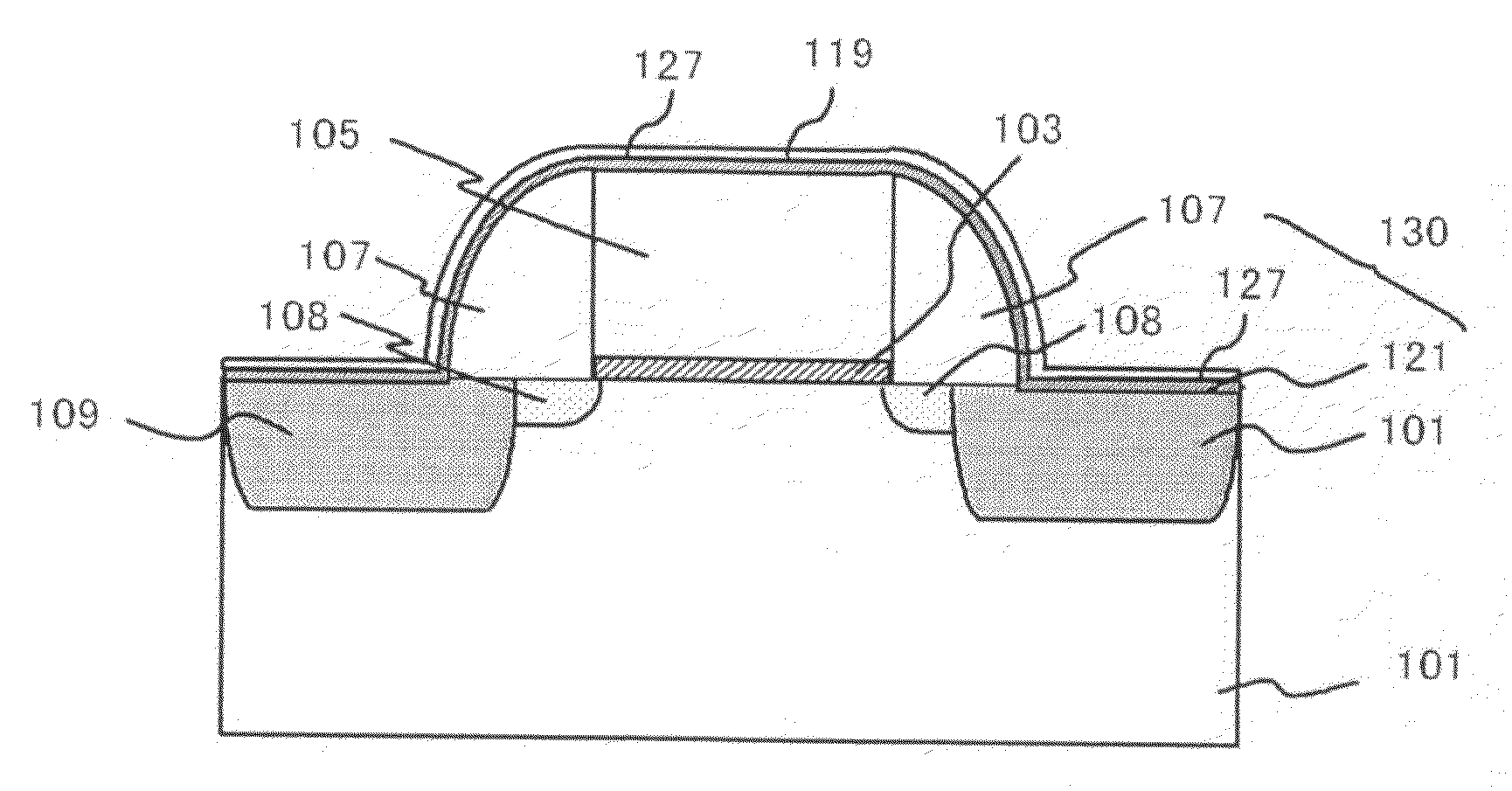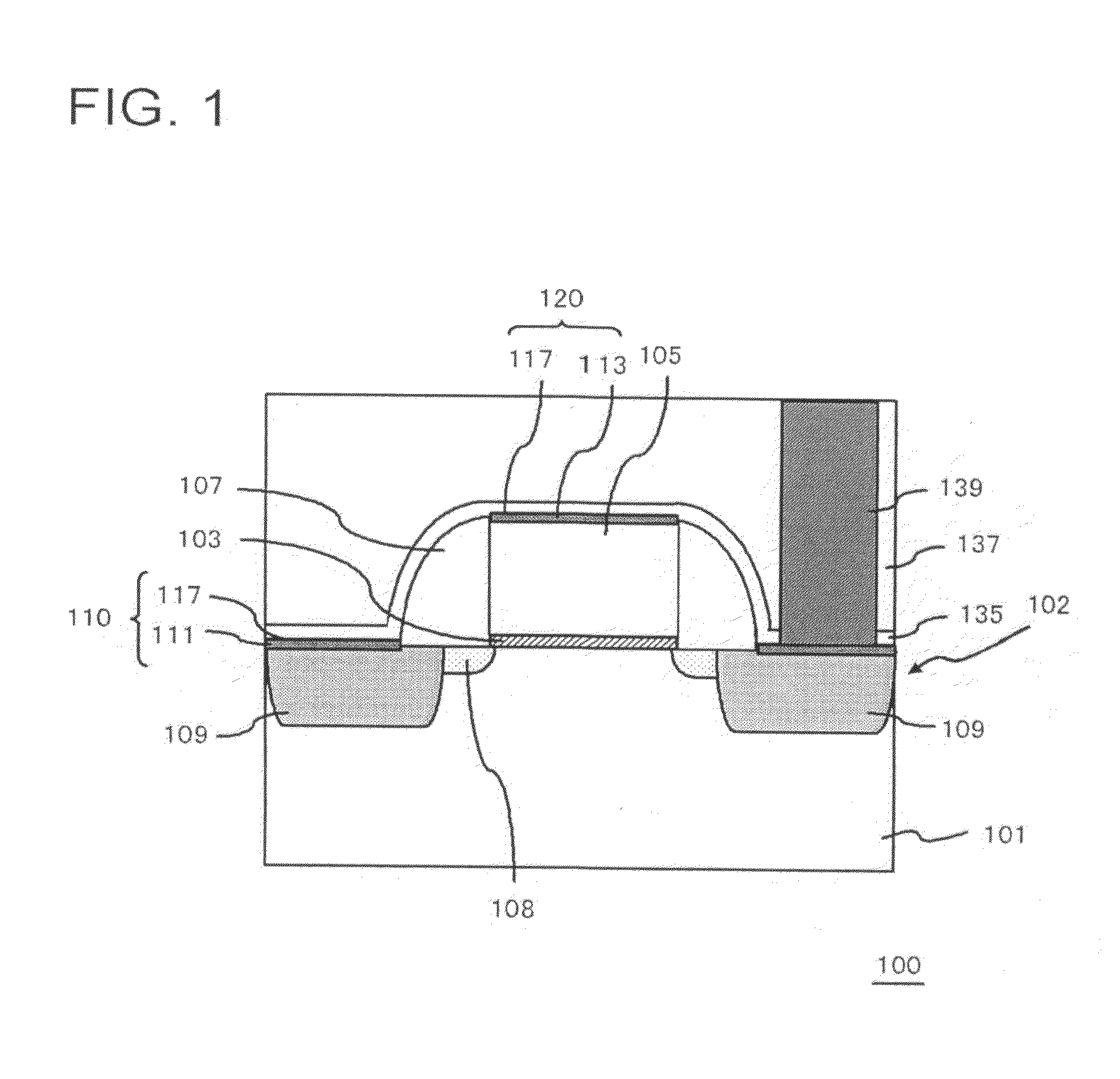Semiconductor device and method of manufacturing the same
a technology of semiconductor devices and semiconductor layers, applied in semiconductor devices, semiconductor/solid-state device details, electrical apparatus, etc., can solve the problems of increasing the resistivity, nisub>2/sub>si, and the tendency to occur abnormal reactions of nickel and silicon, so as to suppress the oxidation of the nisi surface and the increase of the resistivity of the nisi layer
- Summary
- Abstract
- Description
- Claims
- Application Information
AI Technical Summary
Benefits of technology
Problems solved by technology
Method used
Image
Examples
first embodiment
[0047]FIG. 1 is a sectional view showing a configuration of a semiconductor device of this embodiment.
[0048]The semiconductor device 100 shown in FIG. 1 has a silicon substrate 101, and a MOSFET 102 provided on the silicon substrate 101. On the silicon substrate 101 having the MOSFET 102 provided thereto, there are a SiN film 135 and a SiO2 film 137 stacked in this order. In a connection hole penetrating the SiO2 film 137 and the SiN film 135, a connection plug 139 connected to the MOSFET 102 is buried.
[0049]The MOSFET 102 includes a pair of source / drain regions 109 and extension regions 108 provided in the upper surficial portion of the silicon substrate 101, a channel region (not shown) formed therebetween, a gate insulating film 103 provided on the channel region, a gate electrode 105 provided on the gate insulating film 103, and sidewalls 107 covering side faces of the gate insulating film 103 and the gate electrode 105.
[0050]The gate insulating film 103 is typically an oxide fi...
second embodiment
[0129]The first embodiment has explained the case where the TiN film 119 was composed of the stack of the high-nitrogen-concentration TiN layer 123 and the low-nitrogen-concentration TiN layer 125 (FIG. 5A). The TiN film 119 may be configured also as described below.
[0130]More specifically, it is good enough for the TiN film 119 that the high-nitrogen-concentration TiN layer 123 is provided selectively at the interface with the Ni film 115, wherein the upper portion of the high-nitrogen-concentration TiN layer 123 may contain no nitrogen. For example, a Ti layer can be stacked on the high-nitrogen-concentration TiN layer 123.
[0131]Because the high-nitrogen-concentration TiN layer 123 is provided in contact with the Ni film 115 also in this case, effects similar to those in the first embodiment can be obtained.
[0132]Paragraphs in the above have described the embodiments of the present invention referring to the attached drawings only for exemplary purposes, allowing adoption of vario...
example
[0135]In this Example, the semiconductor device 100 (FIG. 1) was manufactured adopting the method described in the first embodiment. A material composing the sidewalls 107 selected herein was SiO2 film. The NiSi layer 110 and the NiSi layer 120 were formed according to the conditions below.
Ni film 115: normal-temperature sputtering, thickness 8 nm;
TiN film 119: normal-temperature sputtering, thickness=10 nm;
High-nitrogen-concentration TiN layer 123: Ar:N2=10:90, 12 kW, 10 seconds;
Low-nitrogen-concentration TiN layer 125: Ar:N2=50:50, 2 kW, 30 seconds;
[0136]First sintering temperature: 300° C., 60 seconds;
Etching for removing unreacted Ni film 115: SPM, 140° C., 2 minutes; and
[0137]Second sintering temperature: 450° C., 30 seconds.
[0138]The total thickness of the resultant NiSi layer 110 was found to be about 20 nm. It was also found that the nitrided region 117 was formed as deep as 2 nm or around from the surface of the NiSi layer 110.
[0139]The nitrogen concentration of the nitride...
PUM
 Login to View More
Login to View More Abstract
Description
Claims
Application Information
 Login to View More
Login to View More - R&D
- Intellectual Property
- Life Sciences
- Materials
- Tech Scout
- Unparalleled Data Quality
- Higher Quality Content
- 60% Fewer Hallucinations
Browse by: Latest US Patents, China's latest patents, Technical Efficacy Thesaurus, Application Domain, Technology Topic, Popular Technical Reports.
© 2025 PatSnap. All rights reserved.Legal|Privacy policy|Modern Slavery Act Transparency Statement|Sitemap|About US| Contact US: help@patsnap.com



